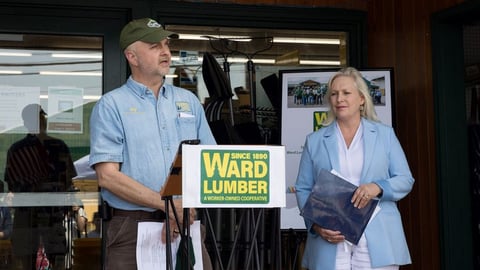Milestone moments for ‘century’ dealers
Experience is the greatest educator. In that spirit, HBSDealer reached out to three dealers with deep wells of business experience to look back at highlight moments from their respective companies.
Each company is a century old, and then some:
• Whitmore Ace Hardware of Wilmington, Illinois, was founded in 1896. The company hit a growth spurt. About 10 years ago, and today operates 13 locations in Illinois.
• Ward Lumber, with two locations in upstate New York was founded in 1890. The company recently converted to a worker-owned co-op.
• Christensen Lumber of Fremont Nebraska celebrated its 100th anniversary in March. The company was acquired by Kodiak Building Partners in 2019. Tom Christensen, grandson of the founder, remains chairman.
Caveat: It’s impossible to capture multiple generations of collective business experience in a few pages. But here are some insights of big moments and big decisions from each of the companies, in the words (mostly) of the current generation of leaders.
Whitmore Ace Hardware of Wilmington, Ill., was founded in 1896 as Whitmore, Cassingham & Co. After a growth surge in 2014, Whitmore Ace now operates 13 stores in Illinois. Co-owner Michael Cripe describes a big moment:
“For my brother (David) and me, the biggest change in the direction of our business came at an Ace Hardware convention nine years ago,” Michael said. “At that time, we had four hardware stores, and our dad was running the company. Up to that point, we had thought we were running pretty good stores and getting as much out of them as we could.
“At the Ace show in Houston 2014, we went out one night with a group of other retailers with stores from around the country. We knew a few of the retailers but got to meet many more that evening. Everyone was sharing information about their stores, markets, and even sales.
“At the time, we were averaging $1.5 million per location. This one conversation made us realize we were not reaching our potential for our stores. If others were able to produce double our sales volume out of similar sized stores in similar type markets, we had a lot more room to grow.
“We looked at our existing product mix, breadth, and depth of inventory. Our product mix at the time was traditional/core hardware, and we didn’t have sufficient inventory on hand. We didn’t have the right mix to attract people of our age, the 30-somethings.
“Fast forward to today, we own and operate 13 locations and have doubled our per-store sales volume.”
Big decisions, bold moves
Ward Lumber of Jay, New York, founded in 1890 embraced the worker-owned cooperative model in 2021. The company made headlines with its progressive succession plan.
“A lot of people have said, boy that must have been a tough decision,” said Jay Ward, president. “You must have thought about that a lot. Well, I consulted with my family, my daughters, who have been involved in the business and love the business but their goals and aspirations have taken them elsewhere. Once they decided that they didn’t want to own and run the business, it really wasn’t a hard decision.
“It is a big decision in the life of a business, but it wasn’t that hard. It just makes so much sense to me for the employee team who are the heart of the company — any company, not just ours—to have the ownership and have the control of the business. They live in it, they operate and run it and care for the customers and the communities. It just makes so much sense to me.
“I don’t want to understate it, It is a big decision because it’s the first time the business isn’t owned by a family member. I’m working on retiring at the end of the year. We’re in the process of hiring a new CEO, and soon there will be somebody not named Ward running the company.”
A memorable highlight for Jay Ward, personally, came eight years into his career with the family business. He explains:
“A Grossmans closed in Plattsburgh, New York., about 45 minutes away from us. I reached out to the real estate agent and we had conversations over a few days. But one moment stands out: I was sitting in a vehicle talking to the agent, and I bought it on the spot, without consulting anybody in my family, my team, my bank, nobody. We ran that location for many years, and it was very successful. So that, for me as a young manager-owner, that was a big deal.”
Christensen Lumber Company of Fremont, Nebraska, celebrated its 100th anniversary in March. Founded as Luehrs-Christensen Coal & Lumber Company, the business survived the upheavals of the stock market crash, and World War II. It survived an arson in 1932. In 1955 it exited the coal business. In 2019, Christensen Lumber joined Kodiak Building Partners.
Tom Christensen, chairman and grandson of company founder Alfred Christensen, pointed to another big moment over the course of an eventful century:
“With the housing recession in the ‘80s, Fremont had a meat packing company here [Hormel] that was also very hard hit,” he said. “And this area went from 230 new houses a year to less than 10. The meat packers were building houses, they were the market back then. On top of that, we had the savings-and-loan crisis. So Fremont was hit really, really hard. We had to look at alternatives. And that’s when I decided to hire my first salesman to go out and work the Omaha market, which was an interesting concept. Before then, we didn’t think that we could get from here to there.
“We added a door shop in 1985, and that turned out to be a good endeavor to be competitive. It worked out really well for taking the business to the next level.”









